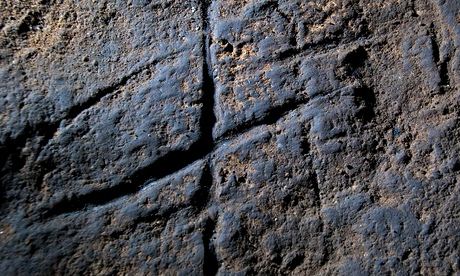Discovery is a significant shift in our understanding of human development, say experts
Stephen Burgen in Barcelona
The Guardian, Tuesday 2 September 2014
The oldest known example of abstract art has been discovered in a cave in Gibraltar. The work, a series of criss-crossed lines cut into stone, was carried out 40,000 years ago.
The work was created by Neanderthals, precursors of modern humans, who until now had been considered incapable of abstract thought and expression.
“Creating paintings or carvings in caves is seen as a cognitive step in human development,” said Prof Joaquín Rodríguez-Vidal of the University of Huelva – one of the researchers whose study of the cave was published in the Proceedings of the National Academy of Sciences on Monday.
 |
| Rock engravings in Gibraltar could be proof that Neanderthals were more intelligent than previously thought. Photograph: Stuart Finlayson/AP |
“This behaviour was considered exclusive to modern humans and has been used as an argument to distinguish our direct ancestors from ancient man, including Neanderthals.”
The discovery is “a major contribution to the redefinition of our perception of Neanderthal culture”, prehistorian William Rendu, of the French National Centre for Scientific Research, told the Wall Street Journal. “It is new and even stronger evidence of the Neanderthal capacity for developing complex symbolic thought.”
The work, uncovered in 2012 and measuring about 10 sq ft, consists of eight lines cut deep into the rock that is arranged in two groups of three long cuts and two shorter ones.
What the engraving signifies is open to conjecture. “At this point we can only guess at its meaning,” said Rodríguez-Vidal. “However, the engraving in the cave is the first directly demonstrable example of an abstract work, carried out consistently and with care and requiring prolonged and concentrated work, that has been produced in a cave.”
Found alongside the engravings were 294 stone tools in undisturbed sediment dating back 39,000 years – about the time when Neanderthals became extinct – meaning the art below it must be older.
The tools are made in a signature Neanderthal style of a type that has never been found at a modern human site, the researchers say.
The Neanderthals reached Europe from Africa some 300,000 years ago.







Add a comment